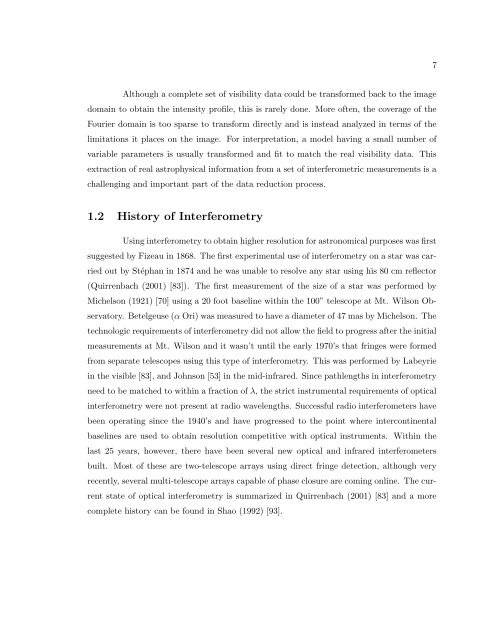The Size, Structure, and Variability of Late-Type Stars Measured ...
The Size, Structure, and Variability of Late-Type Stars Measured ...
The Size, Structure, and Variability of Late-Type Stars Measured ...
Create successful ePaper yourself
Turn your PDF publications into a flip-book with our unique Google optimized e-Paper software.
7<br />
Although a complete set <strong>of</strong> visibility data could be transformed back to the image<br />
domain to obtain the intensity pr<strong>of</strong>ile, this is rarely done. More <strong>of</strong>ten, the coverage <strong>of</strong> the<br />
Fourier domain is too sparse to transform directly <strong>and</strong> is instead analyzed in terms <strong>of</strong> the<br />
limitations it places on the image. For interpretation, a model having a small number <strong>of</strong><br />
variable parameters is usually transformed <strong>and</strong> fit to match the real visibility data. This<br />
extraction <strong>of</strong> real astrophysical information from a set <strong>of</strong> interferometric measurements is a<br />
challenging <strong>and</strong> important part <strong>of</strong> the data reduction process.<br />
1.2 History <strong>of</strong> Interferometry<br />
Using interferometry to obtain higher resolution for astronomical purposes was first<br />
suggested by Fizeau in 1868. <strong>The</strong> first experimental use <strong>of</strong> interferometry on a star was carried<br />
out by Stéphan in 1874 <strong>and</strong> he was unable to resolve any star using his 80 cm reflector<br />
(Quirrenbach (2001) [83]). <strong>The</strong> first measurement <strong>of</strong> the size <strong>of</strong> a star was performed by<br />
Michelson (1921) [70] using a 20 foot baseline within the 100” telescope at Mt. Wilson Observatory.<br />
Betelgeuse (α Ori) was measured to have a diameter <strong>of</strong> 47 mas by Michelson. <strong>The</strong><br />
technologic requirements <strong>of</strong> interferometry did not allow the field to progress after the initial<br />
measurements at Mt. Wilson <strong>and</strong> it wasn’t until the early 1970’s that fringes were formed<br />
from separate telescopes using this type <strong>of</strong> interferometry. This was performed by Labeyrie<br />
in the visible [83], <strong>and</strong> Johnson [53] in the mid-infrared. Since pathlengths in interferometry<br />
need to be matched to within a fraction <strong>of</strong> λ, the strict instrumental requirements <strong>of</strong> optical<br />
interferometry were not present at radio wavelengths. Successful radio interferometers have<br />
been operating since the 1940’s <strong>and</strong> have progressed to the point where intercontinental<br />
baselines are used to obtain resolution competitive with optical instruments. Within the<br />
last 25 years, however, there have been several new optical <strong>and</strong> infrared interferometers<br />
built. Most <strong>of</strong> these are two-telescope arrays using direct fringe detection, although very<br />
recently, several multi-telescope arrays capable <strong>of</strong> phase closure are coming online. <strong>The</strong> current<br />
state <strong>of</strong> optical interferometry is summarized in Quirrenbach (2001) [83] <strong>and</strong> a more<br />
complete history can be found in Shao (1992) [93].













![Problem #1 [Structure Formation I: Radiation Era]](https://img.yumpu.com/37147371/1/190x245/problem-1-structure-formation-i-radiation-era.jpg?quality=85)


